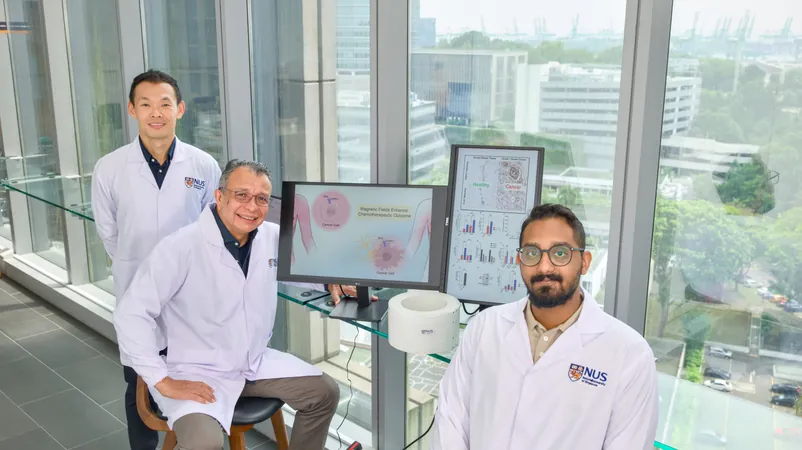
Revolutionary Breakthrough: NUS Researchers Enhance Chemotherapy for Breast Cancer Using Magnetic Fields!
2025-01-06
Author: Mei
Introduction
In a groundbreaking study, researchers from the National University of Singapore (NUS) have unveiled a non-invasive technique that not only boosts the efficacy of chemotherapy but also minimizes the harmful side effects traditionally associated with the treatment.
This innovative approach utilizes brief, localized magnetic field pulses to substantially increase the absorption of doxorubicin (DOX), a chemotherapy drug commonly used in breast cancer treatment, into cancer cells while sparing healthy tissues. This targeted strategy allows for a more precise assault on cancer cells, potentially enhancing treatment outcomes and providing significant relief from adverse effects that often accompany chemotherapy.
The research, spearheaded by Associate Professor Alfredo Franco-Obregón from NUS's Institute for Health Innovation & Technology (iHealthtech), represents the first systematic demonstration of how pulsed magnetic fields can enhance DOX uptake in cancer cells. Notably, the findings indicate the potential for tumor suppression at lower doses of the drug—an exciting prospect for future cancer therapy.
Published in the journal Cancers, the study builds on earlier findings from 2022, which suggested that certain cancer cells exhibit increased sensitivity to magnetic field therapy. Breast cancer ranks among the leading causes of cancer-related deaths in women globally, making the need for innovative treatment methodologies urgent.
Transformative Targeted Therapy: Reducing Side Effects While Fighting Cancer
DOX is a potent chemotherapy treatment that works by binding to DNA, disrupting cell division, and ultimately leading to the death of cancer cells. However, its lack of specificity often results in collateral damage to healthy tissues, leading to severe side effects like cardiomyopathy and muscle wasting.
The NUS team’s research emphasizes a revolutionary advancement: through the application of magnetic fields, they demonstrated an increased uptake of DOX specifically in breast cancer cells via a calcium ion channel known as TRPC1, which is prevalent in aggressive forms of breast cancer. By activating TRPC1 through magnetic field exposure, the researchers could facilitate DOX’s entrance into cancer cells without significantly affecting surrounding healthy muscle tissues.
Through their experiments, they found that breast cancer cells absorbed significantly more DOX when subjected to magnetic pulses, with a mere ten-minute exposure allowing for a 50% reduction in the drug concentration needed to achieve similar tumor-killing effects. Conversely, normal muscle cells showed no increased susceptibility, thereby indicating that the magnetic field application could protect healthy tissues during treatment.
The researchers discovered that inhibiting TRPC1 negated this enhanced uptake, revealing the channel's critical role in this innovative treatment approach. "Our results are compelling. Increasing TRPC1 levels led to higher DOX absorption in cancer cells," stated Vinesh Krishnan Sukumar, a PhD candidate and primary author of the study.
Prof. Franco-Obregón highlighted the significance: "This mechanism is most effective at low drug concentrations, enabling effective targeting of cancerous tissues while alleviating the overall chemotherapy burden on patients."
A Light at the End of the Tunnel for Breast Cancer Patients
The profound implications of this research cannot be overstated. With many breast cancer patients experiencing debilitating side effects during traditional chemotherapy—even leading to premature treatment discontinuation—this localized magnetic therapy offers a viable pathway to improving patient comfort and adherence to treatment.
Assistant Professor Joline Lim, who played a key role in the study, remarked, "Reducing the need for high-dose chemotherapy could also prevent the development of drug resistance, paving the way for more impactful treatment outcomes."
Looking Ahead: The Future of Precision Oncology
The mechanism of magnetic-assisted delivery promises to transform conventional chemotherapy by mitigating its detrimental effects on healthy tissues. This promising methodology could not only enhance patient outcomes and improve quality of life but also encourage earlier intervention in breast cancer care.
Future research efforts will focus on translating these innovative findings into clinical applications by employing localized magnetic field exposure specifically directed at tumors in patients. The goal is to validate this method as a means of reducing systemic DOX doses while maximizing direct delivery to cancer cells.
Prof. Franco-Obregón has ambitious plans, stating, "Our innovative approach will be patented and lay the groundwork for a startup dedicated to advancing breast cancer treatment. We are actively engaging potential investors from Southeast Asia and the United States to bring this pioneering technology from laboratory research to clinical reality."
As the fight against breast cancer continues, this research exemplifies the promising innovations emerging from NUS that could significantly alter the landscape of cancer treatment and enhance the quality of life for countless women worldwide.
 Brasil (PT)
Brasil (PT)
 Canada (EN)
Canada (EN)
 Chile (ES)
Chile (ES)
 Česko (CS)
Česko (CS)
 대한민국 (KO)
대한민국 (KO)
 España (ES)
España (ES)
 France (FR)
France (FR)
 Hong Kong (EN)
Hong Kong (EN)
 Italia (IT)
Italia (IT)
 日本 (JA)
日本 (JA)
 Magyarország (HU)
Magyarország (HU)
 Norge (NO)
Norge (NO)
 Polska (PL)
Polska (PL)
 Schweiz (DE)
Schweiz (DE)
 Singapore (EN)
Singapore (EN)
 Sverige (SV)
Sverige (SV)
 Suomi (FI)
Suomi (FI)
 Türkiye (TR)
Türkiye (TR)
 الإمارات العربية المتحدة (AR)
الإمارات العربية المتحدة (AR)